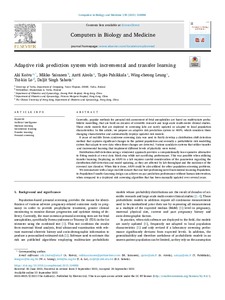| dc.contributor.author | Sahota Daljit Singh | |
| dc.contributor.author | Airola Antti | |
| dc.contributor.author | Lo Tsz-kin | |
| dc.contributor.author | Leung Wing-cheong | |
| dc.contributor.author | Koivu Aki | |
| dc.contributor.author | Sairanen Mikko | |
| dc.contributor.author | Pahikkala Tapio | |
| dc.date.accessioned | 2022-10-28T14:27:44Z | |
| dc.date.available | 2022-10-28T14:27:44Z | |
| dc.identifier.uri | https://www.utupub.fi/handle/10024/171501 | |
| dc.description.abstract | <p><br></p><p>Currently, popular methods for prenatal risk assessment of fetal aneuploidies are based on multivariate proba-bilistic modelling, that are built on decades of scientific research and large-scale multi-center clinical studies. These static models that are deployed to screening labs are rarely updated or adapted to local population characteristics. In this article, we propose an adaptive risk prediction system or ARPS, which considers these changing characteristics and automatically deploys updated risk models. <br></p><p>8 years of real-life Down syndrome screening data was used to firstly develop a distribution shift detection method that captures significant changes in the patient population and secondly a probabilistic risk modelling system that adapts to new data when these changes are detected. Various candidate systems that utilize transfer-and incremental learning that implement different levels of plasticity were tested. <br></p><p>Distribution shift detection using a windowed approach provides a computationally less expensive alternative to fitting models at every data block step while not sacrificing performance. This was possible when utilizing transfer learning. Deploying an ARPS to a lab requires careful consideration of the parameters regarding the distribution shift detection and model updating, as they are affected by lab throughput and the incidence of the screened rare disorder. When this is done, ARPS could be also utilized for other population screening problems. <br></p><p>We demonstrate with a large real-life dataset that our best performing novel Incremental-Learning-Population-to-Population-Transfer-Learning design can achieve on par prediction performance without human intervention, when compared to a deployed risk screening algorithm that has been manually updated over several years.</p> | |
| dc.language.iso | en | |
| dc.publisher | PERGAMON-ELSEVIER SCIENCE LTD | |
| dc.title | Adaptive risk prediction system with incremental and transfer learning | |
| dc.identifier.urn | URN:NBN:fi-fe2021102952989 | |
| dc.relation.volume | 138 | |
| dc.contributor.organization | fi=terveysteknologia|en=Terveysteknologia| | |
| dc.contributor.organization | fi=tietotekniikan laitoksen yhteiset|en=Tietotekniikan laitoksen yhteiset| | |
| dc.contributor.organization | fi=data-analytiikka|en=Data-analytiikka| | |
| dc.contributor.organization-code | 2610300 | |
| dc.contributor.organization-code | 2610301 | |
| dc.contributor.organization-code | 2610303 | |
| dc.converis.publication-id | 67532320 | |
| dc.converis.url | https://research.utu.fi/converis/portal/Publication/67532320 | |
| dc.identifier.jour-issn | 0010-4825 | |
| dc.okm.affiliatedauthor | Koivu, Aki | |
| dc.okm.affiliatedauthor | Airola, Antti | |
| dc.okm.affiliatedauthor | Pahikkala, Tapio | |
| dc.okm.discipline | 113 Tietojenkäsittely ja informaatiotieteet | fi_FI |
| dc.okm.discipline | 113 Computer and information sciences | en_GB |
| dc.okm.internationalcopublication | international co-publication | |
| dc.okm.internationality | International publication | |
| dc.okm.type | Journal article | |
| dc.publisher.country | Britannia | fi_FI |
| dc.publisher.country | United Kingdom | en_GB |
| dc.publisher.country-code | GB | |
| dc.relation.articlenumber | ARTN 104886 | |
| dc.relation.doi | 10.1016/j.compbiomed.2021.104886 | |
| dc.relation.ispartofjournal | Computers in Biology and Medicine | |
| dc.year.issued | 2021 | |
